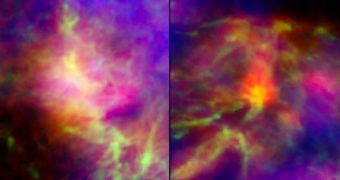According to a recent announcement made by astronomers, it would appear that dust particles inside interstellar clouds can spin faster than ten billion times each second. In the attached photo, the red regions are microwave emissions believed to originate from such fast-spinning particles.
The phenomenon has thus far been observed exclusively in the Milky Way, but experts say that there is no reason to believe it does not appear in other galaxies as well. The new discovery finally helps explains some of the most peculiar radiation in space.
For many years, astronomers have tied the odd microwave radiation with dense molecular clouds usually found in the interstellar medium. However, the exact sources for this energetic light were never accurately established.
The research team operating the European Space Agency's (ESA) Planck space telescope will benefit from the results of this study in their analysis of the Cosmic Microwave Background (CMB), which is the leftover, relic radiation left behind by the Big Bang.
Astronomers say that this event took place more than 13.7 billion years ago, and add that the CMB permeates the Universe. Variations in its temperature are the main arguments for theories such as those supporting the existence of dark matter and dark energy.
Scientists operating Planck were behind the new discovery. Their telescope is sufficiently sensitive to identify tiny dust grains that are between 10 and 50 atoms wide each. These particles are apparently responsible for producing the diffuse microwave “fog” that permeates the Milky Way.
Though a lot of explanations have been attempted over the years, no research team was able to explain the diffuse glow thoroughly. The new Planck observations seem to make the most sense.
“Most of the heavier elements that eventually go into building planets – and even you and me – spent most of their life in this Universe as dust particles,” explains scientist Peter Martin.
“Planck is giving us some of the most detailed surveys of our galaxy's gas and dust structure and distribution, which we think can give us hints to the birthing process of stars and even the way galaxies like ours can form,” he adds.
The expert holds an appointment as a professor of astronomy at the University of Toronto, Daily Galaxy reports.
Planck is currently engaged in a monumental task, and namely to map the distribution of dust and gas in our galaxy, and also to make sense of some of the most complex physical processes ever observed.
These events take place when cosmic gas and dust mingle and interact with stars or with each other. Planck is also conducting an exhaustive investigation into the processes that underlie the formation of new, blue stars.

 14 DAY TRIAL //
14 DAY TRIAL //